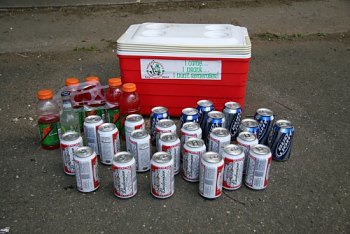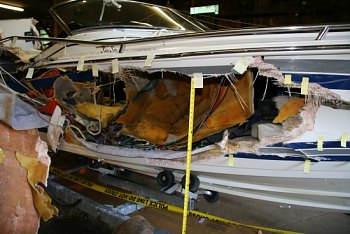On July 19, 2008, three friends spent nearly three hours at a waterfront bar on Candlewood Lake in western Connecticut before climbing into a 365-horsepower Formula speedboat for a ride home.
Just before 1 a.m., the speedboat driven by Richard Layton Jr. of New Milford collided with an 18-foot Triton bass boat carrying two fishermen, according to state investigators. Layton, 33, and a passenger, Jason Wanat, 29, of West Redding, died in the crash, and another passenger, Kevin Sullivan of Bridgewater, was critically injured. The two fishermen escaped serious injury.

Courtesy of DEEP
The cooler, beer and Gatorade recovered by investigators.
Investigation photos show the contents of a cooler recovered from the speedboat: 19 empty beer bottles and cans, 25 unopened beers, and four unopened bottles of Gatorade. A sticker on the cooler reads: “I came…I drank…I don’t remember!” Testing showed Layton had a blood alcohol level of .19, more than twice the legal limit for operating a boat, while Wanat’s level was .13.
The DEEP’s final report blamed the accident on Layton’s reckless driving at an “unsafe speed … while under the influence of intoxicating liquor or drugs.”
The 2008 crash was one of Connecticut’s worst boating accidents in recent memory and came during the state’s deadliest year for boating fatalities involving alcohol since 1998.
“I think it was a real wake-up call for people around the lake,” said Eleanor Mariani, boating division director of the state Department of Energy and Environmental Protection (DEEP).
Though no criminal charges were filed, the crash left a legacy of litigation in the Candlewood community. Three lawsuits were filed against the bar that served Layton’s party. Two other lawsuits named scores of defendants, including officials of the Candlewood Lake Authority (CLA), members of its lake patrol, and the five municipalities that comprise the authority.
The lawsuits against the bar were settled out of court, but the other two are scheduled to begin trial in November, according to court records.
The accident highlights Candlewood’s reputation as the state’s most dangerous lake. Bordered by Brookfield, Danbury, New Fairfield, New Milford and Sherman, the lake had nearly four times as many accidents as did any other inland lake in Connecticut, a review of U.S. Coast Guard data from 1995-2009 showed. There were 74 reported accidents on Candlewood, 19 on Lake Zoar and 16 on Bantam Lake. In all, 69 boaters were injured on Candlewood Lake in that period, while 15 injuries were reported on Lake Zoar, and 10 on Bantam Lake.
Only the state’s two largest boating areas, Long Island Sound and the Connecticut River, had more accidents.
During last year’s boating season, the DEEP made five arrests on Candlewood for boating while intoxicated (BUI)—representing a full third of all such arrests statewide, figures show.
Boat congestion is a major factor on Candlewood, which measures roughly 11 miles by two miles and covers 5,400 acres. A boat survey conducted by CLA during the first few weeks of August 2008 counted 5,677 vessels along its 65 miles of shoreline, and fly-over images showed as many as 637 boats on the lake at one time, more than 90 percent of them powerboats.
Fishing adds to the congestion. Candlewood ranks highest in the number of tournaments and fishing vessels per acre in the state, according to the DEEP. In 2007, the agency permitted about 150 fishing tournaments, nearly three times as many tournaments as approved for Connecticut’s second-largest lake, Lake Lillinonah.

Courtesy of DEEP
Speedboat involved in 2008 fatal accident on Candlewood Lake.
The fatal 2008 crash has fueled an ongoing debate about how crowded boating conditions, alcohol use, and enforcement limitations contribute to the high accident count on the state’s largest lake.
“I personally know four or five people that won’t go back out there because of that [accident],” said Jason Hanakahi, a mechanic who runs the yard at Echo Bay Marina in Brookfield and who has worked on Candlewood for 20 years.
Since the crash, state and local officials have taken steps to reduce the number of alcohol-related accidents, including public awareness programs and tougher enforcement policies. The CLA, the governing body composed of delegates from each of the five towns bordering the lake, is pushing to hire more officers qualified to enforce BUI laws, but budget constraints have kept it from significantly increasing lake patrols, said Larry Marsicano, executive director.
DEEP officials say the agency has stepped up enforcement of BUI laws across the state, specifically targeting Candlewood Lake for increased stops and one-on-one talks with boaters. But facing its own budget issues, DEEP is reducing its presence on Candlewood by one seasonal officer this summer, said Col. Kyle Overturf, head of the agency’s Environmental Conservation Police, with a force consisting of one sergeant and three officers.
DEEP data covering the last 19 years shows that about 10 percent of 116 reported accidents on Candlewood involved alcohol, Mariani said. The two fatal boating accidents on Candlewood in the past decade both involved alcohol. The first fatality was in 2005, when a 48-year-old New York man fell out of his pontoon boat and drowned.
“Candlewood Lake? Very busy. Very congested,” said Michelle Lettieri, a boater and director of victim services for the Connecticut chapter of Mothers Against Drunk Driving. She said she prefers to boat elsewhere because she finds Candlewood too crowded.
Hanakahi and Lettieri say alcohol heightens the dangers presented by crowded conditions.
“Obviously you wouldn’t have as many accidents if the drunk person didn’t have as many things to run into,” Hanakahi said.
Hanakahi, who likes to fish in the early morning, said some boaters get onto the lake and start drinking as early as 7 a.m.
“By the time lunchtime comes, they’re already hammered. And I see people out there that are so hammered, they can’t even see,” Hanakahi said.
Exactly one year to the day after the fatal July 2008 crash, three men were hospitalized when a 24-foot cabin cruiser struck Candlewood’s rocky western shore at 3 a.m. Investigators ruled alcohol was the primary cause and charged the operator with BUI.
In recent years, the CLA has disagreed with DEEP’s public contention that accidents on Candlewood have been decreasing. In 2008, the agency’s commissioner, Gina McCarthy, told a legislative committee that “a review of the boating accidents over the last five years (2003 to 2007) shows a steady decrease in the number of accidents on the lake,” after patrols were increased in 2004. The assessment included a record-high 16 reported accidents in 2004 and considerably fewer for each year after.
But the CLA did its own analysis of a longer period —1995-2008—and concluded in a 2009 report that “no trend in accidents over time since 1995 was observed. This suggests that the pressures from overcrowding on Candlewood Lake are not changing, despite increased patrol activity in recent years.”
Marsicano said that during the busy boating season, the CLA’s Marine Patrol typically has two, occasionally three, boats out at one time, excluding DEEP patrols. The CLA hires up to 25 part-time patrol officers during the boating season, but many lack the training and certification to enforce BUI laws.
The CLA is moving toward hiring more officers authorized to make BUI arrests – typically full-time police officers elsewhere who work part-time on the lake—but finding them “is easier said than done,” Marsicano said. He noted that there are no night patrols.
“We don’t have the resources,” he said, adding that CLA has not increased its patrol force substantially in at least seven years.
Sherman’s director of Parks and Recreation John Wrenn said Candlewood continues to have a reputation as a place where alcohol abuse is a part of boating.
“Budget-wise, everything’s been getting tighter, tighter and tighter. Unfortunately, you get less and less monitoring,” Wrenn said. “[Patrolling] is probably the only way you can lessen it. Lessen it, because you’re never going to stop it.”
As the Candlewood community prepares for another boating season, the legacy of the fatal 2008 crash remains, in the form of two complex lawsuits winding through the court system.
John Wanat, the father of the speedboat passenger who died, is suing 60 individuals and organizations. Defendants include officials and delegates to the lake authority, members of the authority’s lake patrol, and two bass fishing organizations, for allegedly not ensuring that the fishing boat operator had a Connecticut Safe Boating Certificate. Sullivan, the speedboat passenger who survived, is suing most of the same defendants in a separate lawsuit.
Individual lawsuits against the bar that served Layton’s party filed by Sullivan, John Wanat and the bass boat owner were combined last year and settled out of court without any admission of guilt.
The amount was not disclosed, but was reported to be less than $250,000.
Melanie Deziel contributed to this story.
This story was reported under a partnership with the University of Connecticut’s Journalism Department.
